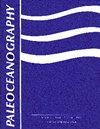Paleoproductivity in the northwestern Pacific Ocean during the Pliocene‐Pleistocene climate transition (3.0–1.8 Ma)
引用次数: 11
Abstract
Alkenone mass accumulation rates (MARs) provide a proxy for export productivity in the northwestern Pacific (Ocean Drilling Program Site 1208) spanning the late Pliocene through early Pleistocene (3.0-1.8 Ma). We investigate changes in productivity associated with global cooling during the onset and expansion of Northern Hemisphere glaciation (NHG). Alkenone MARs vary on obliquity time-scales throughout, but the amplitude increases at 2.75 Ma concurrent with the intensification of NHG and cooling of the sea surface by 3 °C. The obliquity-scale variations in alkenone MARs parallel shipboard measurements of sediment color reflectance (%) with higher MARs significantly correlated (>95%) with darker (opal-rich) intervals. Variations in both lead benthic foraminiferal δ18O values by 1.5-2 kyr, suggesting that export productivity may be a contributing factor, rather than a response, to the extent of continental glaciation. The biological pump is therefore a plausible mechanism for transferring atmospheric CO2 into the deep ocean during the onset of NHG and the ensuing obliquity dominated climate regime. Obliquity-scale correlation between productivity and magnetic susceptibility is consistent with a link via westerly winds delivering terrigenous sediments and mixing the upper water column. Alkenone MARs also contain a ~400 kyr modulation. Because this periodicity is a multiple of the residence time of carbon in the ocean, it may reflect inputs of new nutrients associated with eccentricity forced changes in the terrestrial biosphere and weathering. We ascribe these findings to interactions between the East Asian winter monsoon and productivity in the North Pacific Ocean, perhaps contributing to Plio-Pleistocene climate change.上新世-更新世气候转变期间西北太平洋的古生产力(3.0–1.8 Ma)
在西北太平洋(Ocean Drilling Program Site 1208),从上新世晚期到更新世早期(3.0-1.8 Ma),烯烃质量积累率(MARs)是衡量出口产能的一个指标。我们研究了北半球冰川(NHG)开始和扩展期间与全球变冷相关的生产力变化。在整个过程中,烯酮火星在倾角时间尺度上有所变化,但在2.75 Ma振幅增加的同时,NHG的增强和海面冷却3°C。alkenone MARs平行船载测量沉积物颜色反射率(%)的倾角尺度变化与较高MARs的较深(富含蛋白石)层段显著相关(>95%)。这两种底栖有孔虫的δ18O值变化了1.5-2 kyr,表明出口生产力可能是大陆冰川作用程度的促成因素,而不是响应因素。因此,生物泵是在NHG开始和随后的倾角主导气候状态期间将大气中的二氧化碳转移到深海的一种合理机制。生产力与磁化率的倾角尺度相关性与西风携带陆源沉积物和混合上层水柱的联系相一致。烯酮MARs也含有~ 400kyr调制。由于这种周期性是碳在海洋中停留时间的倍数,它可能反映了与陆地生物圈的偏心强迫变化和风化有关的新营养物质的输入。我们将这些发现归因于东亚冬季季风与北太平洋生产力之间的相互作用,可能有助于上新世-更新世的气候变化。
本文章由计算机程序翻译,如有差异,请以英文原文为准。
求助全文
约1分钟内获得全文
求助全文

 求助内容:
求助内容: 应助结果提醒方式:
应助结果提醒方式:


